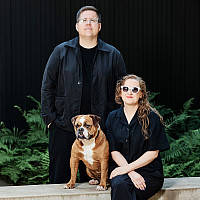2025/2026 School Year
The School of Architecture and Syracuse University are set up to principally support computers with a Microsoft Windows operating system. We no longer recommend Macs as they cannot natively run Boot Camp/Windows, and thus are unable to run essential Windows apps required by the program (including certain energy modeling and rendering plugins in Rhino and Autodesk Revit). Although third-party apps such as Parallels and Fusion allow Windows to run inside macOS, you may encounter performance and graphics issues that impede your work.
The School recommends laptops for easy portability between a residence and studio space. A laptop also can be brought to class when learning software programs. Screen size and resolution are a significant consideration for CAD and graphics work. The most productive combination is a 15”-16” display with an external 24” screen to use at your studio desk. Laptops with smaller screens such as 13”-14” are usually underpowered for advanced graphic modeling and CAD work.
Students should purchase a three- or four-year on-site/at-home service warranty for the computer. An on-site warranty means the company will send someone to your home or meet you on campus to fix the computer, rather than waiting a week or more for mail-in service. In the event of a hardware problem, this will greatly minimize the time a student might not be able to work on time-sensitive computing projects.
Please do not purchase an underpowered machine! While it may meet your needs for the first semester or two, you will soon discover that it cannot handle the demands of design and modeling software.
We recommend international students wait to purchase their machine in the U.S. This will often make it much easier to receive warranty service.
Here are several laptop configurations and specifications recommended for running CAD, graphic, and 3D applications that can be used as a guide to purchase your equipment.
Windows Operating System
| Component | Specs | Notes |
| Processor/CPU |
Intel Core Ultra 7, AMD Ryzen AI 7, or Ryzen 7 8000 series |
A faster cpu and one with more cores means faster 3D rendering time and video encoding. |
| Memory/RAM | 16 GB (32 GB preferred) | 32 GB is becoming the new standard. |
| Storage Drive | 1 TB SSD (solid state drive) | Avoid older style spinning hard drives. |
| Graphics Processor | Nvidia preferred as some advanced software requires it. 8GB memory. Avoid Intel graphics. | For Nvidia we recommend at least a GeForce 5060, 4060, RTX 2000 Ada, or RTX Pro 2000. A GeForce 5070 or 4070 is the sweet spot of price/performance (and for VR development). |
| Screen Size | 15” or 16” | Minimum resolution should be 1920x1080, and anti-glare is better. Keep in mind that 4K resolution (3840 × 2160) impacts general performance and reduces battery life. 2560x1440 (QHD/WQHD) is a good sweet spot, but 1920x1080 or 1920x1200 is ok. |
| Warranty | 3- or 4-year on-site/at-home warranty | Add accidental damage service to protect against drops and liquid spills. |
| Accessories | External mouse | A mouse is essential for using design software (using the built-in trackpad is not sufficient). Example: Dell wireless combo mouse (Bluetooth/2.4ghz dongle). |
| External 24” or 27” monitor with HDMI connector | Plugs into your laptop to double your screen real estate. Don’t forget the cable (and possibly video adapter to convert from HDMI to USB-C). Most current laptops have HDMI or USB-C for video connections. A 27” QHD/WQHD with resolution 2560x1440 is a sweet spot, such as these examples from Dell or elsewhere. |
Expect to pay $1,600-$3,000 for an appropriately configured laptop. Cheaper laptops usually have lower-end graphics processors and may be underpowered to handle advanced 3D modeling and CAD work.
Note: the SU Campus Store may offer a laptop package in July and we will update this page.
Example laptops:
1 - Dell Pro Max Premium 16 (~4.8lbs) or Dell Pro Max Plus 16 (~5.6lbs). Just released but quite expensive (around $4000 w/Ultra 7, 32GB memory, 1TB storage, Nvidia RTX Pro 2000 graphics, 3 year warranty). Last year’s Dell Precision 5690 model is still available (around $3000 w/Ultra 7, 32GB memory, 1TB storage, Nvidia RTX 2000 Ada graphics).
2 - Lenovo ThinkPad P16v Gen 2 (around $2500 w/Ultra 7, 32GB memory, 1TB storage, Nvidia RTX 2000 Ada graphics).
3 - Lenovo Legion Pro 5i (around $2000 w/Ultra 7, 32GB memory, 1TB storage, Nvidia 5070 graphics).
4 - Dell Alienware Aurora 16X (around $2100 w/Ultra 9, 32GB memory, 2TB storage, Nvidia 5070 graphics).
5 - Other gaming laptops when appropriately configured. While we see students with brands such as MSI, Asus, Razer, etc., a concern is that when they fail, one usually has to mail them in for service, resulting in downtime waiting for it to be returned. An at-home/on-site warranty is crucial for getting up and running relatively quickly after a hardware failure.
Macintosh Operating System (MacOS)
We no longer recommend purchase of a Mac, as some essential software used in the program requires Windows (namely certain Rhino plugins such as V-Ray, ArcGIS Pro, Autodesk Revit, ClimateStudio, etc.).
In the past, Mac users could install Windows through Boot Camp, but this option is unavailable on the newer M series Macs. The are a couple of 3rd party apps such as Parallels and Fusion that run Windows inside macOS, but we’ve seen many cases where poor performance and graphics glitches cause problems and frustration. If you choose to try Parallels/Fusion, Windows 10 is free for students.
* Rhino for Mac does not support essential plugins used in the school and is missing commands found in the Windows version.
Other Essential Items
- 128 GB+ USB memory key, although use of SU’s OneDrive is reducing the need for memory sticks.
- External 1 TB+ USB SSD or hard drive for extra storage and backup (available at the bookstore or much cheaper at places like Amazon). You may choose to rely on cloud storage such as OneDrive or Google Drive instead, but it’s always good to have your data in two places. Make sure data that exists only on an external drive is backed up! They can fail at any time.
- External mouse. Bluetooth mice are ideal as they don’t take up a USB port on the laptop. Wireless combo mice that have Bluetooth plus a USB dongle are the most flexible, such as this Dell.
- External 24”+ monitor with HDMI port (plus HDMI cable and USB-C to HDMI adapter, unless your laptop has an HDMI port). If you opt for larger than 24”, such as 27”, make sure the resolution is at least 2560x1440, such as these examples from Dell or elsewhere.
- Cable lock for securing the computer to one’s studio desk. Unfortunately many new laptops no longer include the mounting point for a cable lock. If you can’t use a lock, make sure to keep your laptop in your locked studio desk drawer or locker (if you have one). Losing a laptop to theft can set you back weeks or months of work.











